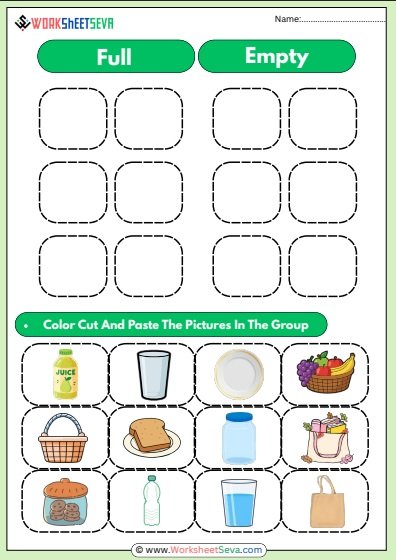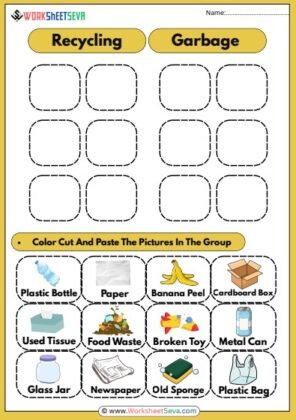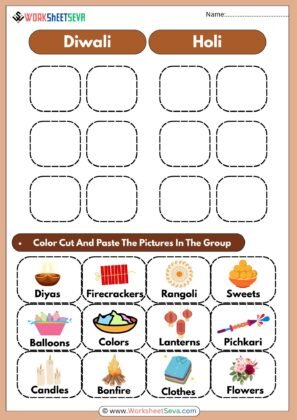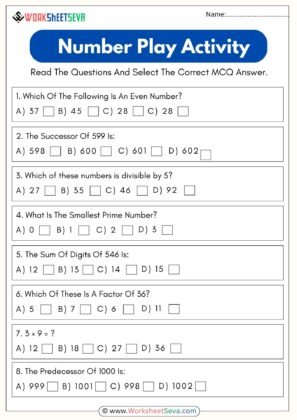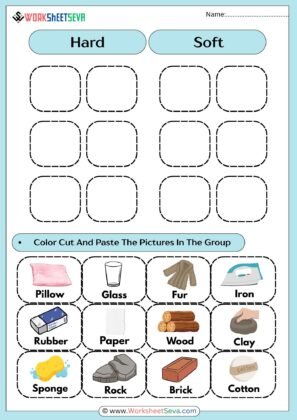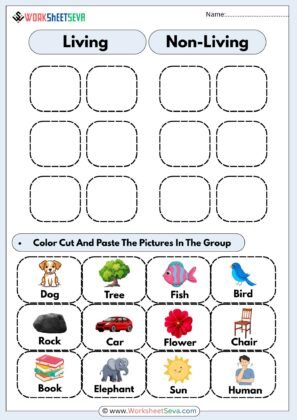Have you ever noticed how children love pouring water, filling cups, or emptying boxes? These small actions are more than just play — they’re early lessons in understanding quantity and space.
Teaching the “Full and Empty Concept” is one of the first steps in developing a child’s understanding of measurement, observation, and logical thinking.
What is the Full and Empty Concept?
In simple terms:
- Full means a container has no more space left inside.
- Empty means the container has nothing inside it.
These two words help children compare quantities and describe the world around them. For example:
- A full glass of milk 🥛
- An empty bucket 🪣
- A half-full bottle of water
When children recognize these differences visually, they begin to understand capacity, volume, and measurement — the foundation for later math and science learning.
Overview of the Worksheet (Based on PDF)
The worksheet from WorksheetSeva.com features two main sections titled “Full” and “Empty.”
Worksheet Structure:
- Two columns: One labeled Full and the other Empty
- Activity task: “Color, cut, and paste the pictures in the group”
- Children are asked to observe, color, cut, and paste images of containers — such as bottles, buckets, glasses, or bowls — based on whether they appear full or empty.
Visual Learning:
Images include:
- A full glass of juice vs. an empty glass
- A full bucket of water vs. an empty bucket
- A full basket vs. an empty basket
This simple layout is perfect for hands-on learning and visual recognition.
Activity Instructions (Step-by-Step Guide)
Here’s how teachers or parents can guide kids through the worksheet:
- Introduce the concept visually:
Show real-life examples — like a full water bottle and an empty one. - Explain the meaning:
“When something has nothing inside, it’s empty. When it’s filled up, it’s full.” - Color the pictures:
- Use bright colors for full objects (e.g., blue for full water).
- Use lighter shades or outlines for empty ones.
- Cut the pictures:
Practice scissor skills carefully under adult supervision. - Paste in the right box:
- Paste full containers under Full
- Paste empty containers under Empty
- Discuss answers:
Ask questions like:- “Which bucket looks full?”
- “Is the bottle empty or full?”
This interaction strengthens comprehension and builds language confidence.
Answer Key: Full and Empty Worksheet
Here’s how to guide children toward the correct answers:
| Image | Answer | Explanation |
|---|---|---|
| Glass filled with water | Full | The glass is filled up completely. |
| Glass with no water | Empty | The glass has nothing inside. |
| Bucket with water | Full | The bucket is holding water up to the rim. |
| Bucket with no water | Empty | There is no liquid inside the bucket. |
| Bowl filled with fruits | Full | The bowl is holding many fruits. |
| Bowl with nothing | Empty | The bowl is empty and clean. |
This structured response helps children visually differentiate between filled and unfilled containers.
Teaching the full and empty concept is more than just recognizing containers — it’s about building awareness, logic, and understanding of the world.
With colorful worksheets, engaging activities, and everyday examples, children can easily grasp the difference between full and empty — all while developing important cognitive and motor skills.
Whether you’re a teacher designing a classroom activity or a parent teaching at home, these worksheets are a fun, visual, and practical way to nurture early math concepts.

